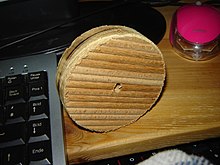Garapa
Garapa or Grapia , is the most common trade name for the relatively light-colored wood of the South American tree Apuleia leiocarpa from the subfamily of the carob family (Caesalpinioideae).
Geographical distribution
The trees grow in southern Brazil, northern Argentina and Paraguay in tropical South America .
Tree shape
The trees are medium to large in size and reach heights of up to 25–35 meters and trunk diameters of 0.8 to 1.20 meters. The trunks have a straight, cylindrical habit. The knot-free lengths are up to about 12 meters.
Properties of wood
The grain of the wood is straight to alternately twisted. In terms of color and structure, Garapa is a predominantly homogeneous wood with a fine to medium texture and high density. The wood pattern can vary from simple to decorative, depending on the grain. The heartwood is lemon yellow when fresh, but darkens brown over time and does not contain any streaks of color.
Sapwood corresponds in color to the heartwood or is clearly differentiated from the heartwood in color. The sapwood is very wide (50 to 110 mm) and pale yellow to beige. The boundaries of the growth zone are either clearly recognizable (marked by a darker latewood band) or indistinct or not recognizable. When fresh, the smell is reminiscent of almonds, otherwise the smell is not pronounced or not present.
Garapa dries slowly with little tendency to deformation and cracking (surface and end cracks) and thus has a moderate to good staying power. It is slow to absorb or release moisture. The information on the weight of the wood varies depending on the dealer (density 790 - 830 kg / m³ with 12% wood moisture, fresh to over 1,000 kg / m³).
Areas of application and use
Garapa is mainly used for gardening and terrace construction. Due to its high durability, the extraordinary hardness (compressive strength 63 N / mm²) and the resulting good durability, also outdoors, it is used, among other things, for buildings on and in the water. The wood is as good as knot-free, and especially at the ends only finely cracked, it contains very little resin. Garapa does not work as hard as other comparable hardwoods (shrinkage: 7.5% tangential, 4.4% radial).
Machining
The wood can be sawn well, and planing also works well to moderately. Due to the alternating twist, a slow feed rate and a small cutting angle are recommended to achieve clean planing results. Tools dull quickly due to the high silicate content, the use of carbide-tipped tools ( Stellite ) is recommended. Garapa can be sanded well and the surfaces are perfectly smooth.
Web links
- Garapa at DELTA commercial timbers .
- Garapa (PDF) GD Holz, Leaflet Series Wood Types Sheet 111, from ZEG Zentraleinkauf Holz + Kunststoff eG, accessed on May 15, 2019.
